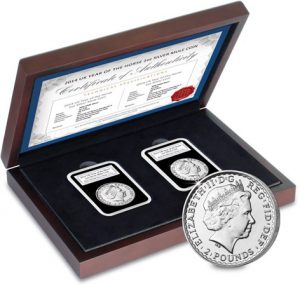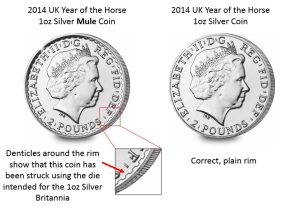Posts Tagged ‘Error coin’
Errors, Mules and Mis-strikes: Why the 2014 Year of the Horse Silver Coin is so sought after
We all have our favourite coins to collect, whether it be historic coins, special 50p designs or coins from around the world.
But one thing that piques the interest of almost all collectors, including myself, is the elusive ‘error’ coin.
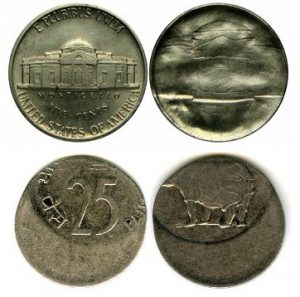
Examples of error coins – top: nickel brockage error, bottom: Indian 25 paise mis-strike
Considering the high levels of technology involved in minting coins and the number of different quality controls in place, it is extremely rare that a coin is minted with an error. And it is even rarer for an error coin to be released to the public.
However, over the years there have been sporadic cases of error coins being struck and issued to the public. Just a few things that would be considered an error would be an off-centre strike, a crack in the die or even use of the wrong die completely!
And that last one is exactly what happened to the 2014 Year of the Horse Lunar Silver Coin when it was incorrectly struck with the distinctive denticle obverse of the 2014 Britannia coin.
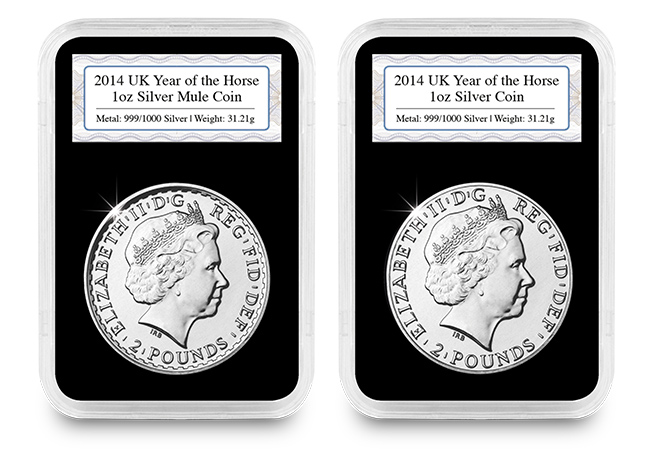
Comparison of 2014 Year of the Horse error and non-error coin
After an investigation, it was discovered that approximately 38,000 Year of the Horse coins were struck with the incorrect denticled edge on the obverse. And once The Royal Mint confirmed this as a genuine error, these coins understandably became incredibly sought after.
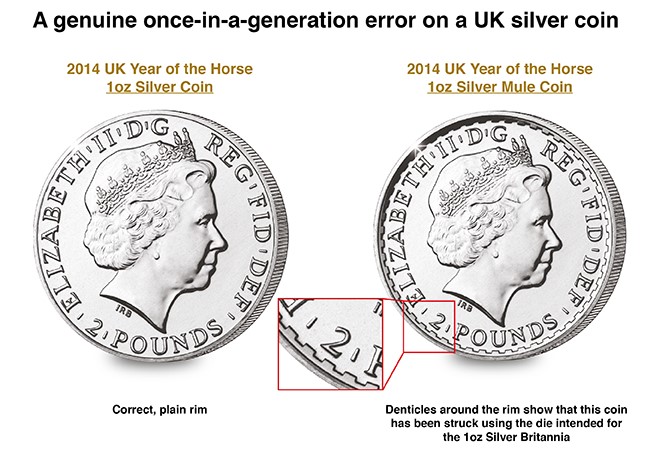
2014 Year of the Horse explanation of error
What makes these error coins particularly desirable is that, because it was issued as a bullion coin, many were sold around the world to coin dealers and investors. That means that they are much harder for the British public to track down. Plus, of course, in terms of pure numbers struck they are considerably scarcer than previous errors such as the ‘undated 20p’.
In fact, Ebay listings have seen the value of these coins soar to around 30 times their original value! So if you are lucky enough to own the 2014 Year of the Horse coin, I’d suggest you go and have a closer look at it!
We have a small number of the ‘Year of the Horse Silver Mule Sets’ available to buy. This set contains the Year of the Horse error coin alongside the correct version of the coin for easy comparison. This ‘mule’ is an absolute must for any collection and is extremely rare, so secure yours today.
2014 Year of the “Mule”: the Royal Mint confirms Lunar Year and Britannia striking errors
If you own the 2014 Year of the Horse Lunar Silver Coin or the 2014 Britannia coin, I suggest you go and dig them out before you read any more. That’s because it’s just possible that you are sitting on something rather unusual – a Royal Mint “mule”.
A “mule” is a coin where the one of the sides has been struck with the wrong die. And that’s what happened with some of the Royal Mint’s 2014 Year of the Horse and Britannia coins.
Officially confirmed by the Royal Mint
It seems attention was first drawn to the matter when a US dealer noticed that some of their Britannia coins had a different obverse (heads) side to the rest of the stock, lacking the denticle design around the edge, normally seen with Britannia coins.
The Royal Mint has now acknowledged the error, which has resulted in approximately 17,000 Britannia coins being struck with the non-denticled Year of the Horse obverse and 38,000 Year of the Horse coins having the denticled Britannia version as their obverse.
Selling for 250 times its original value
Perhaps the best recent example of a UK mule in recent years was the undated 20p coin, which was uncovered in 2008. Approximately 250,000 20p coins were struck using an old obverse design, which left them undated. The news was followed by a media frenzy with many millions of people searching their change in the hope finding what was to prove to be a valuable error. Indeed an undated 20p currently changes hands on ebay for around £50 – 250 times its original value.
So what of these latest Royal Mint errors? Unlike the 20p these are not general circulation coins but as bullion coin they will have been sold around the world to coin dealers and investors. That means that they will be much harder for the British general public to track down. Plus, of course, in terms of pure numbers struck, they are considerably scarcer than the undated 20p.
Early listings on ebay have been as high as £500 and above, so if you are lucky enough to own either the 2014 Britannia or Year of the Horse coins, I would definitely dig them out and take a look – it might be your lucky day.

